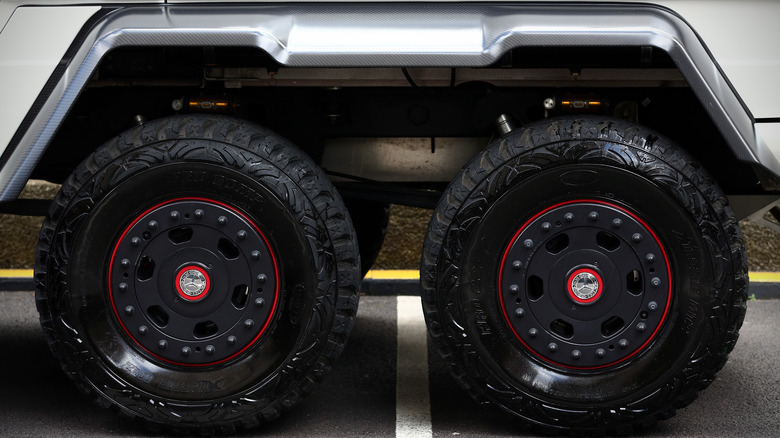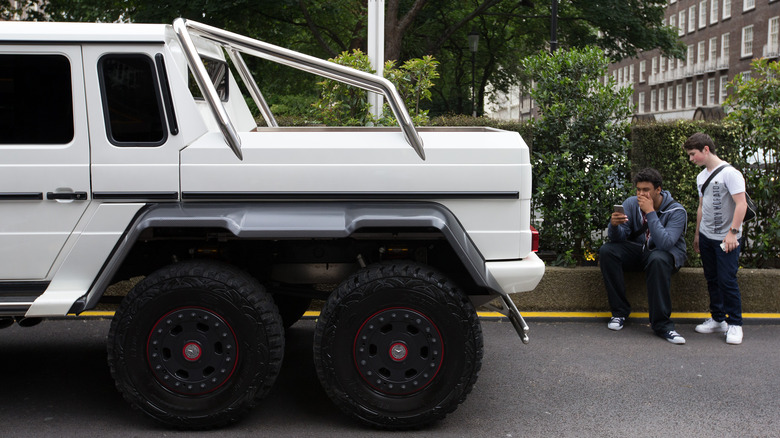5 Head-Turning Features That Make The Mercedes G-Wagon 6x6 So Unusual
Mercedes-Benz clearly knows how to make a top-notch luxury vehicle, with their S-Class being the benchmark for executive luxury for decades and their expanding catalog of SUVs quickly providing an SUV-hungry market with even more luxurious options. They also know how to make a very capable off-roader, as can be seen with the time-honored G-Class, as well as the lesser-known but very capable Unimog. On top of that, they also know how to make excellent performance cars, from the comparatively accessible (if you have the dough) to the generally inaccessible to the entirely-inaccessible unless-you're-Lewis-Hamilton-or-George-Russell.
Over the years, Mercedes-Benz combined its knowledge in these areas to give consumers a wide range of vehicles that combined luxury with speed, such as the S 63 AMG. If you needed luxury, speed, and the ability to ford rivers, you had the G 63 AMG. But what do you do when even that is not enough? What if you wanted a vehicle that could go almost anywhere and over almost anything, keeping you in the lap of luxury while doing it? If you're Mercedes-Benz in the early 2010s, you take a G 320 CDI 6x6 designed for the Australian military, replace its boring diesel engine with a gas-powered twin-turbo V8 from your high-performance division, add on as many off-road and luxury upgrades as you possibly could, and then sell the whole outrageously long, tall, and wide package for over half a million dollars as the Mercedes-Benz G 63 AMG 6x6.
The 6 wheels and accompanying tech
The most obvious of all of the Mercedes-Benz G 63 AMG 6x6's features was its third axle and two extra wheels. With power being delivered to all three axles and with each wheel encased in a 37-inch tire, the 6x6 made more than enough contact with the ground to be able to drive over (or through) almost anything.
However, adding the extra wheels and tires was only the beginning. The 6x6 came with an incredible set of off-roading technology to get the most out of its increased allotment of rubber. The wheels themselves were special — they had bead lockers, which ensured that the tires would stay firmly attached even when aired down to very low pressures. The 6x6 also included an onboard pressurized air system, with which the driver could quickly deflate and reinflate the front and rear tires simply by pressing a few buttons in the cabin.
In addition to the incredible height afforded by its massive tires and suspension system, the G 63 gained even more ground clearance thanks to the inclusion of portal axles. Due to their significant complexity, portal axles are rarely seen outside purpose-built off-road vehicles, such as the Unimog, but Mercedes-Benz saw fit to equip the 6x6 with them too. The 6x6's off-road capability was further improved by including five electronically locking differentials and a transfer case with a reduction gear, allowing it to power across any terrain.
The engine and exhausts
Mercedes-Benz chose its 5.5-liter twin-turbo V8 to power the G 63 AMG 6x6, replacing the 3.0-liter V6 diesel found in the military version manufactured for Australia. Pumping out 544 horsepower and 560 foot-pounds of torque, the M157 AMG engine could also be found in other high-performance vehicles, such as the S 63 AMG and G 63 AMG of the time.
With so much power on tap, the 6x6 could go from 0-60 mph in under eight seconds, which may not sound like much until you take its curb weight of over 9000 pounds into account. With its boxy design, chunky tires, massive size, and power to match, it was about as efficient as one would expect. Mercedes-Benz claimed it could return anything between 21 and 12 mpg, though you could still travel considerable distances with two tanks carrying a total of 40 gallons of fuel.
Compared to the standard G 63's flashy side exit exhaust pipes, the 6x6 came with a comparatively conservative setup. What made it unusual was that while most cars have their exhaust pipes at the back, the one on the 6x6 ended under the middle of the vehicle (though in a similar location to the original vehicle). As a purely functional component, they weren't visible unless you got under the vehicle, but being connected to a 5.5-liter biturbo V8, the exhaust note still sounded fantastic.
The truck bed
With the addition of an entire extra axle and two more 37-inch tires, the entire body of the G Wagon needed to be stretched. To achieve this, Mercedes-Benz decided to extend the entire cabin of the G-Class and then graft a truck bed to the back of it. This increased the vehicle's total length by close to four feet, going from the G-Class' comparatively compact 187.75 inches to a whopping 231.3 inches.
Replacing the G-Class rear door with a tailgate-equipped truck bed posed a problem — where to put the full-size spare tire. On most G-class SUVs, the spare tire could be mounted to the rear door, allowing easy access. As this could not be done with a tailgate, Mercedes-Benz instead opted to relocate the spare to the inside of the bed itself. This robbed the bed of precious space, as it was already narrower than most would expect, having sacrificed space to make way for the air tanks needed for the 6x6's tire inflation system. However, something tells us that this probably didn't impact the owners of this half-a-million-dollar vehicle too much. The bed also saw the addition of a striking stainless-steel roll bar for added protection and presence.
Interestingly, the addition of the bed to the 6x6 also made it the first modern Mercedes-Benz pickup truck, predating the ill-fated X Class by a few years, even though it was manufactured in much smaller numbers.
The luxury upgrades
As the largest and most expensive luxury vehicle in the Mercedes-Benz lineup (aside from possibly Maybachs), the G 63 AMG 6x6 was packed to the gills with luxury features. Like a top-of-the-line S-Class, the rear bench had been removed and replaced with a pair of AMG sports seats, all the better to hold your passengers in place as you careen across whatever you see before you. These leather seats, much like their counterparts up front, were electrically powered and had heating and cooling functions to ensure you stayed as comfortable as possible in any kind of climate.
The leather was not limited to the seats alone. It was also used liberally over the rest of the 6x6's interior, with Mercedes-Benz giving buyers options on which colors they wanted for their two-tone seats via their Designo program. A center console was also added to the space between the two rear seats for even greater comfort. Changes were also made to the exterior, with massive carbon-look wheel arches, more lighting, and the signature AMG grille.
The third-party upgrades
In case the Mercedes-Benz G 63 AMG 6x6 wasn't already outrageous enough for you, third-party vendors such as Brabus and Mansory were almost immediately ready to turn things up to 11 with their own upgrades to make sure that there was no way anybody could possibly ignore your six-wheeled behemoth.
For instance, Brabus took the 6x6 and cranked out what it called the Brabus B63S – 700 6x6. As the name implied, the engine had been extensively upgraded and tuned to deliver 700 hp and 708 lb-ft of torque. The interior and exterior were also improved, including more meta and finely-stitched leather inside and even more carbon fiber and lighting on the outside.
Meanwhile, Mansory took a similar approach, just taking things even further. First, the engine was reworked to boost power and torque significantly. With the addition of a host of components, they managed to wring a supercar-beating 829 brake horsepower and 738 lb-ft of torque out of the 5.5-liter biturbo V8. It then came out with two trim levels: the Xtreme and the Gronos. Both received opulent interiors featuring a range of materials, including Alcantara, wood, and aluminum. You could also opt for a blue leather interior and an illuminated ceiling similar to Rolls-Royce's Starlight headliner. Additions were also made to the exterior, including copious amounts of carbon fiber and lighting. Also, the Gronos specifically came in bright yellow paint to make it even harder to miss.




